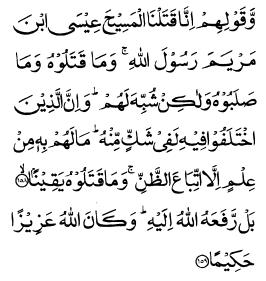Download These Images in .jpeg HERE

And their saying, 'We did kill the Messiah, Jesus, son of Mary, the Messenger of Allah;' whereas they slew him not, nor crucified him, but he was made to appear to them like one crucified; and those who differ therein are certainly in a state of doubt about it; they have no definite knowledge thereof, but only follow a conjecture; and they did not convert this conjecture into a certainty; On the contrary, Allah exalted him to Himself. And Allah is Mighty, Wise. (4:158-159)The emphasis is upon their failure to murder Jesus by any means. The reader is reminded that the very beginning of the verse refers to the Jewish boast that they had succeeded in murdering Jesus.
This Jewish claim is firmly rejected by the Holy Quran. That is
why by the end of verse, the conclusive declaration is that whatever may have
happened they certainly failed to kill him. This implies that it is not the act
of crucifixion which is denied. What is denied is death by crucifixion.
Walakin Shubbiha Lahum: the word Shubbiha in
the text must be carefully studied. The context of the preceding verse would
not permit the implied reference to any other than Jesus or alternatively it
could refer to the incident in general. In conformity with the rules of grammar the
implied pronoun in the word Shubbiha can refer to none other than Jesus Christ
himself. This means that it was he who was obscured and made to appear to them
similar to someone else. Hence as Jesus was hung upon the cross he hung in the
likeness of someone else. Evidently the denial is not that of crucifixion or
apparent death thereupon but the denial is death by crucifixion. There was
certainly great confusion as to what actually happened. So the verse continues
to build the scenario of confusion and doubt. All else is nothing but
conjecture. That is the final conclusion.
If the word Shubbiha refers to the incident as
such, this would point to the diverging claims of the two disputing parties as
to what had happened. Neither of the parties were certain of the validity of
their claims. For instance the belief of Jesus' death by crucifixion and later
resurrection was not based on any tangible grounds but was merely conjectural.
Likewise the Jewish claim of Jesus' death upon the cross was no less
conjectural. Hence their appeal to Pilate for the possession of Jesus' body. In
fact they clearly expressed their doubts regarding the entire episode of his
so-called death and they warned Pilate that in the likelihood of his survival
he might reappear in public claiming that he had risen from the dead (Matthew
27:63-64).
It is to this that the last part of the verse under study refers,
when it says wa innalladhina. Certainly those who differ about it (or about him
as to what actually befell him) were themselves in doubt.
Bal rafa'ahullahu ilaihi: the majority of
orthodox Muslims infer from this part of the verse that the connotation of Bal
refers to the act of crucifixion i.e., instead of letting him die upon the
cross, God rescued him by raising him bodily to somewhere in the heavens. As
such he should be living somewhere in space in the same corporeal form that he
possessed prior to the attempt of his crucifixion. This interpretation raises
many difficult questions, mainly:
(a) If Jesus was not crucified at all, is the entire history of
crucifixion emphatically denied and the whole episode just a fiction or
delusion suffered by the Jews, the Christians and the Romans alike?
(b) Where in the verse is the claim that Jesus was raised bodily
to the heavens? All that is mentioned simply is that God exalted him to
Himself.
As to the first question the orthodox build a fantastic scenario
according to which the fact of the crucifixion itself is not denied but is
claimed that the person who was crucified was not Jesus but someone else who
was given the likeness of Jesus by some angels at the command of God. Hence the
doubt and conjectures were about the identity of the person who was crucified.
Evidently this explanation creates only more problems than it solves. Moreover
the entire tale is absolutely without foundation. No scriptural evidence or
evidence based on the traditions of the Holy Prophet (may peace and blessings
of Allah be upon him) is ever presented to support this bizzare claim which
simply adds more conjectural confusion.
It is as if this explanation of the verse dawned only upon the
medieval scholars while the Messenger of God, peace be upon him, remained
himself completely unaware of it.
As to the second question the weakness of the claim is apparent
from the wording of the Holy Quran. The word rafa'a means
elevated. Whenever Allah elevates a person the elevation always refers to the
status of the person, never to his body. In fact it is impossible to translate
this verse in any way other than the said meaning i.e., the elevation of
spiritual station.
The verse declares that Allah elevated Jesus to himself. Evidently
no point in space of the heavens is mentioned to which Allah raised him. He
raised him to Himself while He was present where Jesus was. No place in heaven
or earth is empty of Allah's presence. So when someone is said to be raised to
Him, a bodily movement is impossible and inconceivable. According to the
Ahmadiyya understanding of this verse, the connotation on the contrary refers
to the Jewish claim of the accursed death of Jesus. Obviously the opposite of
curse is nearness to God.1
1. The Holy Quran translated by Maulvi Sher Ali published by
Islam International Publication Ltd 2006; notes under verse
4:158, 159.

Comments
Post a Comment